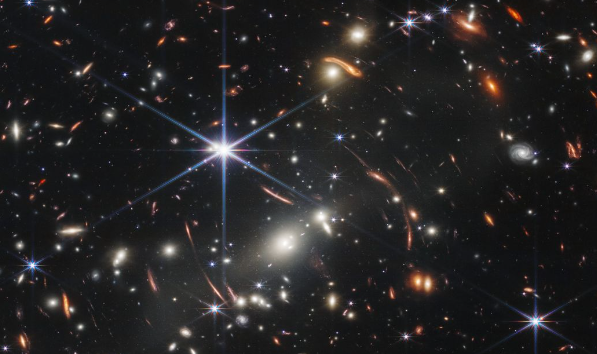Introduction
The James Webb Space Telescope (JWST) continues to revolutionize our understanding of the cosmos. Recently, it made a groundbreaking discovery of the earliest known giant galaxy, ZF-UDS-7329, which formed just 800 million years after the Big Bang. This discovery not only pushes the boundaries of our knowledge but also challenges existing cosmological models.
The Discovery
The galaxy ZF-UDS-7329 was identified using the James Webb Space Telescope advanced infrared capabilities, allowing astronomers to peer back in time to the universe’s early stages. This galaxy, larger than our Milky Way, contains more stars and showcases complex structures that were previously thought to form much later in cosmic history.
Significance of the Discovery
This finding is significant because it suggests that massive galaxies formed much earlier than previously believed, requiring a re-evaluation of current models of galaxy formation. Traditional theories posited that dark matter halos needed more time to coalesce and form such large structures. The existence of ZF-UDS-7329 indicates that early galaxy formation was more rapid and complex than understood.
Advanced Technology of the James Webb Space Telescope (JWST)
The James Webb Space Telescope (JWST’s) Near-Infrared Camera (NIRCam) and Near-Infrared Spectrograph (NIRSpec) are crucial in detecting and analyzing distant galaxies. These instruments can see through cosmic dust and capture faint infrared light from the earliest galaxies, a capability beyond the Hubble Space Telescope. This technological leap enables astronomers to study the universe’s infancy with unprecedented clarity.
Characteristics of the Giant Galaxy

ZF-UDS-7329 is a behemoth, containing a vast number of stars and exhibiting a sudden cessation in star formation. This abrupt halt is puzzling, as it suggests unique processes at play in the early universe. The galaxy’s formation without sufficient dark matter challenges existing models, pushing astronomers to reconsider the mechanisms behind galaxy formation and evolution.
Implications for Astronomy
The discovery of ZF-UDS-7329 has profound implications. It necessitates revising theories of how galaxies form and evolve, highlighting the need for new models that can accommodate the rapid formation of massive galaxies. This finding also opens up the possibility of discovering more such ancient galaxies, further altering our understanding of the early universe.
Future Research Directions
The James Webb Space Telescope will continue to explore the depths of the cosmos, aiming to uncover more secrets about the universe’s early stages. Future research will focus on identifying additional ancient galaxies and understanding the processes that enabled their rapid formation. These studies will likely lead to significant advancements in cosmology and astrophysics.
Conclusion
The discovery of the earliest giant galaxy by the James Webb Space Telescope marks a milestone in astronomy. It challenges existing theories and opens new avenues for understanding the universe’s early stages. As James Webb Space Telescope continues its mission, we can anticipate more groundbreaking discoveries that will further expand our knowledge of the cosmos.
The James Webb Space Telescope’s findings underscore the importance of advanced technology in exploring and understanding the universe. These discoveries are crucial in piecing together the history of the cosmos and shaping our comprehension of galaxy formation and evolution.
Sources:
- Live Science
- NASA Science
- Scitech Daily
- Astronomy.com
- UCSC News








